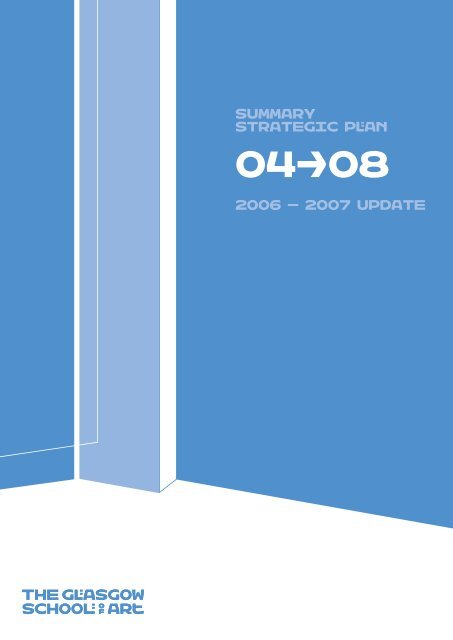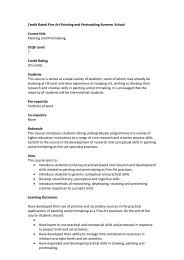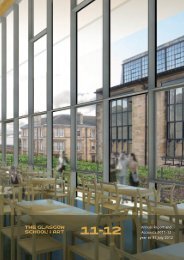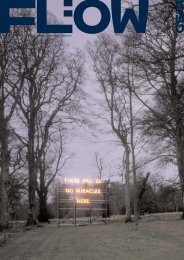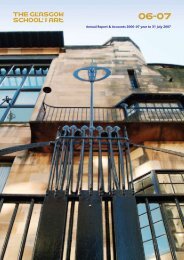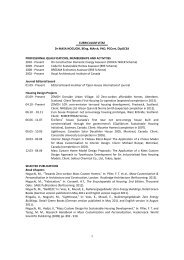Summary Strategic Plan 04-08 (Update 06/07) | Download pdf
Summary Strategic Plan 04-08 (Update 06/07) | Download pdf
Summary Strategic Plan 04-08 (Update 06/07) | Download pdf
Create successful ePaper yourself
Turn your PDF publications into a flip-book with our unique Google optimized e-Paper software.
Our visionTO prOvide WOrLd-cLasscreative education andresearch in architecture,design and fine art,which makes a significantecOnOmic, sOcial andcultural cOntributiOn.
contentsO4O61O13151617IntroductionCreative and Cultural> The Creative Industries> Creativity and the Knowledge Economy> The Cultural RoleThe Education Environment> Learning and Teaching> Widening Access> Postgraduate Growth> Research> Knowledge TransferPeople and Place> People> Place> FinanceVision and ObjectivesPriorities for 20<strong>06</strong> – 20<strong>07</strong>Strategies and <strong>Plan</strong>s 20<strong>06</strong> – 20<strong>07</strong>
O4INTRODUCTIONintroductionThe Glasgow School of Art enjoys an international reputationfor the quality of the studio-based education we provide, for theexcellence of our staff, for our many successful alumni and for ourdeveloping areas of research excellence. This reputation has beenbuilt over many years and over those years the School has remainedsuccessful because it has been responsive to change in artisticpractice and change in its environment.The thoughts of Charles Darwin in The Origin of Species arerelevant here“It is not the strongest of the species that survive, nor the mostintelligent, but the ones most responsive to change”
O5`INTRODUCTION> This plan sets a course for 20<strong>08</strong> and during thatperiod we continue to face change: significant andcontinuous change in society, in the higher educationsector and in the professional sectors to which werelate. As in previous centuries, The Glasgow Schoolof Art faces the challenge of finding ways, not only tosurvive but to thrive, in an environment characterisedby rapid transformation and to do so without losingthe qualities that built the international reputation ofwhich we are so proud.The vision of The Glasgow School of Artremains constant:To provide world-class creative education andresearch in architecture, design and fine art whichmakes a significant cultural, social and economiccontribution.The way in which we achieve the vision will changeas we respond to the demands of students and thesociety in which we live. The plan is not fixed. Itprovides a framework within which the professionalismand creative potential of all our staff can shape andcontribute to the developments, ideas and partnershipsthat ensure we rise to the challenges ahead.
O6CREATIVE AND CULTURALcreative and culturalThere is every sign that the day of the creative individual andthe creative organisation has come.THE CREATIVE INDUSTRIESThe sectors most closely associated with thedisciplines taught at The Glasgow School of Art arenow considered to be of national importance and setfor growth. Creative industries are recognised as amajor force in the economy generating 1.9 millionjobs across the UK. A reflection of their importance isthe appointment of a Minister for Creative Industriesto the UK Government and the launch of a creativeeconomy programme. The Government has statedits intention of making the UK “the world’s creativehub” and projects significant employment andoutput growth. In Scotland the creative and culturalindustries account for 5.7% of total employment,generating 4% of GDP and are set to grow between10 and 20% per annum. Glasgow also has thehighest concentration of creative and culturalindustries outside London and the South East.Despite this, Scottish Enterprise’s new strategy isto focus on six national economic sectors which donot include creative industries except those whichoperate within electronic markets. This must be aconcern to creative industries in Scotland.Education has a key role in developing creativeindustries through the development of the talentand skills base and by stimulating innovationthrough research and commercialisation.The Glasgow School of Art and the other art, designand architecture colleges and faculties acrossScotland, have already played an important rolein building the creative and cultural industries inScotland. But we could do much more.To help to develop the talent and skill base forcreative industries we need to increase our capacityparticularly at postgraduate level. Indeed, ScottishEnterprise Glasgow in its Framework Document forCreative and Cultural Industries 1 talks specificallyabout the need to increase postgraduateopportunities in creative disciplines. Our ambition isto increase the percentage of postgraduate studentsfrom its current 8% to 15% in 20<strong>08</strong> and 22% by2015. There is strong evidence of demand both interms of applications to our current postgraduateprogrammes and in terms of global trends 2 .Additional funds provided by the Scottish FundingCouncil for research postgraduate provision iswelcome but there is still a lack of taughtpostgraduate funded places to support this ambition.There are only 141 postgraduate funded places in artand design across Scotland 3 (of which GSA has 57.5).This is disproportionately low when compared, forexample, with the 833 postgraduate funded placesavailable to Computing Science with equivalentundergraduate numbers to art and design. As a resultthe financial viability of courses becomes overlyreliant on fee income from overseas students whoare, in the main, less likely to move into the localcreative industries and Scotland loses many talentedgraduates who will seek postgraduate opportunitieselsewhere. We have, therefore, embarked on a study,funded by SFC, into the funding of postgraduateprovision in creative disciplines to build the case forenhanced support.To support creative industries we also need to makethe transition from study to work more seamless.Again Scottish Enterprise Glasgow talks about theimportance of ladders of support to creativegraduates. We developed a graduate bridging project– Insight Out – in partnership with NESTA and theLighthouse 4 which is now being rolled out to therest of the UK and is the basis for the pan ScotlandStarter for Six enterprise scheme for creativegraduates to be launched as part of the Six CitiesFestival of Design. We also continue to promoteemployability across the School, embedding core and1 Scottish Enterprise Glasgow: Framework Document for the Creative and Cultural Industries 20<strong>04</strong>2 British Council with IDP Global Change Drivers and sample Forecasting Scenarios 2003: Scottish Funding Council: Higher Education in Scotland: A baseline report 20053 2005-6 Scottish Funding Council Main Grant Letter4 National Endowment for Science, Technology and the Arts and the Lighthouse Centre for Architecture, Design and the City
O7CREATIVE AND CULTURALtransferable skills including enterprise learning firmlyand explicitly into our project-based curriculum,piloting innovative new approaches like Insight OutLearning which appeal to creative minds, supportedin this by the Scottish Institute for Enterprise 5 .Our success in moving people into the creativeand cultural industries sector has been confirmedby a recent study of GSA graduates between 1999and 2003. Over 87% are in employment includingself employment, 9% are undertaking furthereducation and only 1.7% are unemployed. 86%were in jobs which related in whole or in part totheir degree subject.The international competitiveness of Scottishcreative industries will be driven not simply bythe size of the sector but also by its capacityfor innovation and invention. The research andknowledge transfer activity that is being developedat The Glasgow School of Art is an important meansof driving innovation and invention but the verysignificant and welcome increase in Governmentfunds for knowledge transfer in higher educationgenerally is not finding its way to the creativedisciplines. The metrics being used to allocatefunds are quite simply inadequate in respondingto creative disciplines and the needs of creativeindustries. Although we welcome the recognitionby the SFC that Scottish higher education makes asignificant cultural contribution and the introductionof the cultural engagement income stream, itcannot substitute for more inclusive metricswhich capture the full range of knowledge transferin creative disciplines.Of course, the creative industries themselves andthe nature of practice in fine art, design andarchitecture change at a relentless pace. Our courses,the research and the knowledge transfer activity weengage in must remain relevant both to the creativeand cultural industries and, increasingly, to the widersociety. Regularly reviewing course content and theoverall relevance of the course portfolio isembedded in our planning. In particular, oureducation and research must reflect the increasinginter-disciplinary of creative practice. A good starthas been made in encouraging synergies acrossour Schools and Departments; in developinginter-disciplinary courses at undergraduate andpostgraduate levels and in our emerging areaof inter-disciplinary research.CREATIVITY AND THE KNOWLEDGE ECONOMYThe creativity, which The Glasgow School of Artnurtures, is increasingly valued in the wider society.Sir George Cox in his Review of Creativity inBusiness 6 argues that “creative capability lies at thevery core of our ability to compete” and is “a key tofuture business success and national prosperity” andin Smart Successful Scotland, 7 the Scottish Executiveacknowledges that Scotland’s “economic successdepends on the people of Scotland, their creativityand enterprise”. Glasgow City Council and ScottishEnterprise Glasgow are developing a new EconomicStrategy for the city and it is heartening that theGSA, a voice for the creative sector, is representedon the Steering Group and that, as part of thatdevelopment, a higher education forum for the cityhas been established to focus on promoting two ofits major strengths – creativity and health andwellbeing.In one of the most influential books on the economyto be published recently, The Rise of the CreativeClass, Professor Richard Florida of Carnegie MellonUniversity 8 argues that “creativity is now the decisivesource of competitive advantage. In virtually everyindustry, from automobiles to fashion, food productsand information technology itself, the winners inthe long run are those who can create and keepcreating…creativity has come to be the most highlyprized commodity in our economy”.Florida’s new theoretical construct for economicdevelopment is based on three pillars. Firstly,those who are creative in their work now representa significant class in society (approximately 30%of the workforce in the USA, 25% in Europe 9 )Secondly, the health of the economy depends onits ability to nurture, attract and retain creativepeople. Thirdly, creative people are drawn to cities,which comprise large numbers of creative people,which are socially diverse and tolerant, and whichhave a rich cultural life.5 Scottish Institute for Enterprise Innovation Grant for the development of Insight Out Learning6 Review of Creativity in Business: Building on the UK’s strengths. Sir George Cox 2005 HMSO7 A Smart Successful Scotland: Ambitions for the Enterprise Network. Scottish Executive 20<strong>04</strong>8 The Rise of the Creative Class – and how it is transforming work, leisure, community and everyday life. Richard Florida. 2002. Basic Books ISBN0-465-02476-99 Demos 2005
O8CREATIVE AND CULTURALIn this framework, The Glasgow School of Art’s rolein the economy is twofold.Firstly we develop graduates with the qualitiesneeded by today’s wider economy – creative lateralthinkers, enterprising, self-motivated, risk takers. Weneed to strengthen our efforts to ensure that thevalue of creative education is clearly understood bygovernments, by employers, by educationalists, byfunders and last but not least, by our graduates.Secondly, we help to build and sustain in Glasgowa cultural environment which acts as a magnet tocreative people. The city of Glasgow is fast building aninternational reputation as a dynamic centre for visualculture and the GSA continues to play a defining rolein that reputation. We need to promote that rolewithin the City and, in partnership, develop it.The GSA attracts students from all over the world,many of whom wish to stay, thereby contributingboth to the cultural profile of the city, to thecreative industries and, directly and indirectly, tothe economy. In 2005–<strong>06</strong> 11% of the total studentcommunity comprised overseas students and ouraim is to increase this proportion to 21% by 2014in order to build a truly international campus. Aswith growth in postgraduate provision, there isstrong evidence of existing and future demand. 10A joint first year programme with the CentralAcademy of Fine Art in Beijing, for example, willbring in 40 highly able Chinese students each yearto complete their design and architecture degrees atthe GSA. The Master of Fine Art course has 50%overseas students and global trends suggest thatgrowth in other postgraduate areas will followsimilar patterns. The Scottish Executive Fresh Talentinitiative supports overseas students who wish toremain in Scotland after graduation. The GSA, withEdinburgh College of Art and funded by the ScottishExecutive, has established a work shadowing schemefor international students to build professionalnetworks which will ease transition to work and withsupport from the City Council and local developmentagencies, a robust creative infrastructure shouldsustain them in the City.Joseph Beuys’ prophetic statement – “creativity isnational income” – has never been truer than itis today!THE CULTURAL ROLEThe importance of our cultural life was affirmedwhen the First Minister of Scotland in his StAndrew’s Day address in late 2003 talked about thecentrality of cultural activity to all aspects of ourlives. He wanted Scotland to have the “courage andfaith to back human imagination, our innate creativity,as the most potent force for individual change andsocial vision”. In particular he sees our culturalreputation playing a significant part in creating animage of Scotland abroad which is modern, diverseand dynamic. In response, a new Cultural Policy waspublished in 20<strong>06</strong> asserting that culture would beplaced at the heart of Scotland’s policy makingagenda, cutting across all portfoliosof government.In his guidance to SHEFC in January 2005, theMinister for Enterprise and Lifelong Learningemphasised the importance of culture and creativity,stressing that the HE sector has an important role indeveloping cultural activity, awareness and expertisethrough creating wider access to cultural activity andhelping to develop creative talent across differentsectors of the economy.The Knowledge Transfer Task Force of the ScottishHigher Education Funding Council also recognisedthe cultural role of higher education. Followingconsultation 11 a small dedicated stream ofknowledge transfer funds has been allocated,unfortunately formulaically, for cultural engagement.In return HEIs will be required to develop culturalstrategies.The Glasgow School of Art’s cultural engagementof course takes many forms. There is the work ofour staff, students and graduates; our exhibitionprogrammes; our continuing education classes andsummer schools and the access we give the publicto our heritage – the magnificent Charles RennieMackintosh building which remains at the heart ofour campus and the School’s rich collections and10 British Council with IPD 200311 Cultural Engagement: an imperative for Higher Education. Scottish Higher Education Funding Council March 2005
O9CREATIVE AND CULTURALarchives. Glasgow City Council is leading the bid tohave Mackintosh Masterpieces which comprise theArt School and his most famous domestic building,Hill House, inscribed as a World Heritage Site byUNESCO. Internationally, too, The Glasgow Schoolof Art enhances Scotland’s profile and reputation.Our staff win international accolades. Our studentsexhibit internationally – in 2005–<strong>06</strong> for example, theMaster of Fine Art Degree Show exhibition visitedBeijing and Tokyo. And our graduates representScotland in disproportionate numbers – 100% ofthe artists representing Scotland at the 2005 VeniceBiennale were GSA graduates as were 60% of thedesigners representing Scotland at the 20<strong>04</strong>International Design Fair in Milan.In a world increasingly caught up in instrumentaljustifications it is important to assert the importanceof art and artists for their own sake. We continueto take pride in nurturing artists who enrich ourlives, who help us see things from new perspectives,who engage our emotions and our senses. This isjustification enough.
1OTHE EDUCATION ENVIRONMENTTHE EDUCATION ENVIRONMENTThere are challenges and opportunities also in the higher education environment.The Scottish Executive’s Framework for Higher Education in Scotland Phases 1 – 3 12 ;its Lifelong Learning Strategy 13 ; the Treasury’s Lambert Review of Business-UniversityCollaboration 14 ; the merging of the higher and further education funding councilsto form a single Scottish Funding Council and the outcome of the review into theResearch Assessment Exercise 15 provide a clear statement of Government priorities forthe future. The changing nature of society, the changing profile and needs of students,too, are major factors in planning our education and research of the future.LEARNING AND TEACHINGThe key challenge for the education sector is torecognise a significant shift in society towardslifelong learning because, in Alvin Toffler’s words“The illiterate of the 21st Century will not be those whocannot read and write but those who cannot learn,unlearn and re learn”The seamless progression of a learner throughdifferent levels of education was the rationalebehind the introduction of the Scottish Credit andQualifications Framework (SCQF) and the emphasison improved articulation for students betweenfurther and higher education. The demographicchanges facing the UK, with reductions in thenumber of 17–24 year olds, means that thetraditional market for higher education is decliningand this, too, demands a different response fromeducation providers. The overall demand, therefore,is for a greater focus on the needs of a wider rangeof students and on flexible modes of delivery andsupport services which respond to those differingneeds.The GSA is responding to these challenges byembracing the SCQF; by exploring different – andparticularly part time – modes of delivery and byworking with partner Further Education Colleges –Langside, Cardonald and Glasgow MetropolitanColleges – to explore closer working relationshipsand articulation routes for students.The Enhancement Led Institutional Review formsa major part of the new quality assurance andenhancement regime introduced in 20<strong>04</strong>. The GSA’sInstitutional Review in early 2005 resulted in theQuality Assurance Agency reporting BroadConfidence, the highest of three bands, in themanagement of the quality of our provision andthe academic standard of awards. It also highlightedgood practice in studio based learning, wideningparticipation and student services. The Reviewprovided an invaluable opportunity to shine a lighton the way in which the School manages andcontinually enhances the quality of its learning andteaching and assures standards. As a result, we haveembarked on a number of academic developmentsincluding the introduction of common academicframeworks for undergraduate and postgraduateprogrammes to facilitate and support enhancedinter-disciplinarity; a common code of assessmentacross the School and a review of academic rolesand responsibilities.The Glasgow School of Art has an internationalreputation for the excellence of its education.Continuous reflection and quality enhancementis the way to ensure we keep it. Another way isto nurture deep engagement between staff andstudents across international networks of likeminded institutions of equal educational standingthrough the many exchange programmes,international workshops and joint programmeswhich we sustain.Students are increasingly concerned about howtheir education equips them for the transitioninto the world of work. The GSA, like other HEIs isexploring the most effective means of addressingthis employability agenda through an activeEmployability Group. Core and transferable skills,including live projects, are now embedded in thecurriculum across the School. Pilot work placement12 Scottish Executive A Framework for Higher Education in Scotland Phases 1 – 3 2003–413 Scottish Executive Life through Learning for Life: The Lifelong Learning Strategy for Scotland, February 200314 H.M .Treasury: Lambert Review of Business-University Collaboration December 200315 H.M.Treasury: Science and Innovation Investment framework 20<strong>04</strong>–2014: next steps. HMSO, 20<strong>06</strong>. Chapter 4: Supporting Excellence in University Research, p.29
11THE EDUCATION ENVIRONMENTand work shadowing schemes have beenestablished and are working well. Increasing use isbeing made of the services of the Scottish Institutefor Enterprise with sterling work being undertakenby our SIE student intern. In 20<strong>06</strong> GSA designstudents won the SIE National Business <strong>Plan</strong>competition fending off stiff competition fromstudents from every other university and discipline.We were also supported by SIE in developingInsight Out Learning, a web based resource foracademic staff to integrate enterprise learning intothe curriculum, which has been rolled out acrossthe UK. And we have been working with theLighthouse and NESTA to develop a pan Scotlandenterprise academy for creative graduates whichcan support the development of creative businessesand ideas.WIDENING ACCESSWidening access is a priority for The Glasgow Schoolof Art. Our widening access programme tacklesrecruitment, admissions and retention. In all three,progress is being made. A successful portfoliopreparation scheme contributes to the increasingapplications we receive year on year from peoplefrom disadvantaged backgrounds: our admissionspolicy and procedures have been thoroughlyreviewed and improvements introduced and ourexcellent student support service, integrated intomainstream learning and teaching, helps to ensurethat retention rates for wider access students ismaintained at or near the level of other students.The relatively low level of students from minorityethnic communities remains a cause for concernand research into the causes is underway.We see no contradiction between widening accessand continuing to provide the world-class educationin art, design and architecture to which we aspire.Quite the opposite.POSTGRADUATE GROWTHThe planned growth of postgraduate (taught andresearch) 16 provision serves the economic andcultural needs of Glasgow and Scotland as has beennoted in earlier sections, but it is also essentialacademically. In order to attract the best studentsnationally and internationally the School must buildon existing subject specialist strengths with anexpanded range of postgraduate opportunities.A critical mass of students will engender aculture of “postgraduateness” which will becomeself sustaining. Students will have progressionopportunities in all subject areas from undergraduateto doctoral levels and the School’s researchstanding will be sustained by an expanding pool ofpostgraduates to match the quality and intensityof research in key areas.RESEARCHThe Government’s agenda for higher educationresearch and knowledge transfer is also becomingclearer.Higher education research in Scotland is alreadysuccessful and internationally competitive. TheScottish Executive wants to enhance this successby increased targeting of research funding towardsareas of international excellence whilst maintainingsupport for emergent disciplines and institutionswith growing research profiles.The Scottish Executive has also acknowledged thatmuch interesting research is developing in the areasbetween traditional discipline boundaries. This iswhere some of The Glasgow School of Art’sresearch interests also lie with advanced researchcentres like the Digital Design Studio increasinglyworking in areas such as medicine and navalarchitecture; and with emerging research themessuch as Living Cities and Inclusive Design takingan explicitly inter-disciplinary approach. The Centrefor Creative Education, too, will look at applicationsfor creativity in other sectors of education andof society and the proposed Centre for SocialInnovation which will bring creativity, technologyand business together in a collaboration with theUniversities of Glasgow and Strathclyde and theLighthouse, and is a response to the Cox Review ofCreativity in Business, will undertake research whichdelivers demand driven radical innovation acrossthe service sector.We would, however, also defend vigorously researchwhich achieves excellence within traditionaldisciplines and research centres in drawing, in16 See Creative and Cultural: The Creative Industries, Page 3
12THE EDUCATION ENVIRONMENTenvironmental architecture, in digital textiles, inart in social contexts and in the GSA archive andcollections are also being pursued.But, of course, the Government agenda is not theonly reason why The Glasgow School of Art hashigh ambition for its research. World-class research,which engages with the professional sectors,industry and the community, makes a significantcontribution to society and that is part of ourvision. It also connects us to global networks,enriches teaching, ensures that we remaininternationally competitive and able to attractexcellent staff and students.The increased quality research funding whichfollowed our improved performance in the 2001Research Assessment Exercise has provided anexcellent foundation to support our aspirations.It has allowed investment in essential infrastructure– a high performing central research office with aHead of Research and Postgraduate Studies anda PhD Co-ordinator; Research Developers, PhDCo-ordinators and Senior Researchers in eachschool, Researchers and Visiting Professors; and theintroduction of accredited PhD supervisor training.Our ongoing strategy is to develop and sustain oureight research centres to achieve internationalexcellence; to develop strength in research themeslike Living Cities and Inclusive Design; to increasethe proportion of research active staff; to increasethe number of PhD students attached to centresand themes, and to enhance the internationalquality of research outputs throughout.20<strong>06</strong>–<strong>07</strong> is, of course, the run up to the 20<strong>08</strong>Research Assessment Exercise and the GSA’spriority, like that of every other higher educationinstitution in the UK, will be to invest time andenergy in putting forward the best possible casefor the quality of our research.Business-University Collaboration it is set toincrease significantly.The Glasgow School of Art engages enthusiasticallyin activities which make a contribution to theeconomy and to the GSA’s financial health . Theyinclude the commercialisation of intellectualproperty such as 3Motion, a human-computerinteraction device; the work of the Centre forAdvanced Textiles bringing digital textiles designand print expertise to local and internationalbusinesses; the consultancy services providedby the Mackintosh Environmental ArchitectureResearch Unit into energy efficient housing; andthe creative businesses which develop fromstudent designs being licensed for production.Research projects now all specify not only theresearch outputs but also the knowledge transferoutputs which are expected and the developmentof each new postgraduate taught programmeincludes an assessment of the potential formodules being made available separately ascontinuing professional development training.We also, as has been said, make a majorcontribution to the cultural life of the nation –the exhibitions, publications, student projects,continuing education classes, conferences, lecturesand seminars and, last but not least, our heritageboth as the guardian of Charles RennieMackintosh’s masterwork and collections andas one of the oldest art schools in the UnitedKingdom. This too is knowledge transfer in itsbroadest sense and that this is now acknowledgedby SFC is a very positive development.KNOWLEDGE TRANSFERSo important has knowledge transfer become forGovernment, that the funding provided to supportit is being seen as the Third Stream after Teachingand Research. Post the Lambert Review of
13PEOPLE AND PLACEPEOPLE AND PLACEPeople and place are the two most important factors in sustaining world-classeducation and research. The Glasgow School of Art must continue to be characterisedby excellent staff and must build a strong resource base if it is to fulfil its ambitions.PEOPLEThe Bett Report 17 still remains a potent force inshaping the human resource landscape in highereducation. The agreement between the Universitiesand Colleges Employers Association (UCEA) andthe trades unions on a single pay spine supported byrobust job evaluation has far reaching consequencesnot least in the ability of institutions like the GSA tomeet the inevitable costs without additional funding.For the GSA, the implementation of this NationalPay Framework is set within a broader frameworkof a coherent new pay and rewards strategy and areview of technician roles.Alongside Bett, lies the Government’s commitmentto facilitating professional development andimproving the professional standing of staff in highereducation through the establishment of the HigherEducation Academy and the Leadership Foundationfor Higher Education. This priority the GSA shareswith the Government and much use has alreadybeen made of the excellent schemes and servicesprovided by both. In particular, accredited academicpractice training for new and existing academic staffis now in place which will facilitate membership ofthe HEA by a growing proportion of academic staff.The GSA can only provide world-class education andresearch if we can continue to recruit, develop andretain high quality staff. We have made substantialprogress in modernising the human resources serviceat the GSA and in establishing a comprehensivehuman resources strategy: our efforts must besustained into the future. Career review and personaldevelopment planning has been introduced and willcontinue to be rolled out across the institution.Activity planning has been introduced to helpdetermine the balance between teaching, researchand other responsibilities for academics to meetmore effectively the needs of the individual and theneeds of the School. Further investment in staffdevelopment and leadership development for seniorstaff is essential to improve effectiveness in bothacademic and support departments.The effectiveness of the School’s Board of Governors,already reviewed internally on a regular basis, cannow be measured against a new UK wide Code ofGovernance. It has not been found wanting.PLACEEducation is now a global sector. Our competitorsare no longer just Edinburgh, Aberdeen or Dundeebut institutions throughout the world. The qualityof the teaching, the international standing of theGSA staff, the sense of the GSA community and thereputation of Glasgow as a dynamic creative cityremain the most important factors in maintaining ourcompetitive edge. The physical environment of theGSA is, however, in danger of seriously undermining it.The Garnethill campus is very poor. It failsto provide a learning, teaching or researchenvironment which is in any way adequate to meetthe ambitions of the School in terms of its quality,its flexibility, its cost effectiveness, or the image itprojects to future students, staff and partners.Neither can it accommodate the growth in overseasand postgraduate students which isso essential to our continued financial viabilityor support the expansion and enhancement ofresearch and knowledge transfer activity as westrive for international excellence and profile.The creation of a high quality, fit for purposecampus designed for the 21st Century is a majorfactor in ensuring the School remains nationally andinternationally competitive. It will require verysignificant investment from public andprivate sectors.17 The Independent Review of Higher Education Pay and Conditions: Report of the Committee chaired by Sir Michael Bett June 1999
14PEOPLE AND PLACEHaving concluded on the basis of studies into thecondition of the estate, its fitness for purposeand the utilisation of space that only a majorredevelopment could sensibly address the School’sacademic aims and the estate’s inadequacies,an options appraisal was commissioned and apreferred option agreed. The plan is to redevelopand rebuild on two sites around the MackintoshBuilding and 200 metres down Renfrew Street. Twoother properties would be sold. On this basis a FullBusiness case was developed and submitted to theScottish Funding Council. Discussions are underway.The grade A listed Mackintosh Building remainsat the heart of the estates redevelopment. AStage1 agreement for funding of £4.466m hasbeen secured from the Heritage Lottery Fund forthe Mackintosh Conservation and Access Project.If confirmed at Stage 2, the grant will enable usto conserve and restore the building, collectionsand institutional archives; bring studios and otherapartments back to their original use; create newexhibition areas and an interpretation centre andincrease the number of visitors without compromisingthe building’s primary purpose as a working artschool. Already funding of £6,791,000 has beensecured from public and private sources.Located in House for an Art Lover in BellahoustonPark, the growth plans of the ground breakingDigital Design Studio are also constrained by itscurrent accommodation. The DDS ambition is torelocate to the Digital Media Campus on PacificQuay and discussions are underway with a developerand Scottish Enterprise.In England, higher education institutions arebenefiting not only from additional support formodernising pay structures but also, from 20<strong>06</strong>onwards, from the ability to charge variable feesthat will bring in a stream of additional teachingincome which is not assured in Scotland.The redevelopment of the estate also has majorfinancial implications. The bulk of the capitalinvestment must, by necessity, be secured frompartners in the public and private sectorsbut the School must be able to maintain its newestate adequately and fund any limited borrowingrequired.To achieve these goals the School’s strategy isto generate significant additional income over theplanning period and beyond and to minimise capitalexpenditure in the short to medium term in orderto increase liquidity further. The School will secureadditional income by increasing overseas studentnumbers, increasing research income and by thecommercialisation of products and intellectualproperty, particularly those in development at theDigital Design Studio. It will also generate fundsby the sale of existing buildings freed up as thecampus is concentrated.These are ambitious plans which requiredetermination and the collaboration of a wide rangeof partners from the public, private and personalsectors of society. The staff and Board of the GSAare convinced that the value of the GSA and itscontribution to society, locally nationally andinternationally, merit such faith.FINANCEBoth people and place can be sustained only throughan effective financial strategy.The context is challenging. Increases in SHEFCfunding have remained below the real costs ofimplementing national pay awards. The new NationalPay Framework will be in place in 20<strong>06</strong>–<strong>07</strong> and,given that pay at GSA represents well over 60% ofexpenditure, will have significant costs – in bothdesigning and implementing the new pay structures.
15VISION AND OBJECTIVESVISION AND OBJECTIVESThe vision of The Glasgow School of Art is:To provide world-class creative education and research inarchitecture, design and fine art which make a significantcultural, social and economic contribution.We will achieve that vision by fulfilling 5 major objectives:OBJECTIVE 1OBJECTIVE 2OBJECTIVE 3OBJECTIVE 4OBJECTIVE 5To provide creative education of the highest qualityTo ensure our student community reflects thediversity of societyTo develop research of international standingTo use our research, expertise and resources tobring benefit to Glasgow, Scotland and beyondTo be an organisation characterised by excellentstaff and a strong resource baseThe following pages detail the strategies which have been agreed for the fouryear period from 20<strong>04</strong> – 20<strong>08</strong> and the main plans identified for 20<strong>06</strong> – 20<strong>07</strong>. Thefull strategy, which includes a report on progress in 2005 – 20<strong>06</strong>, student numberprojections and a summary of the income and expenditure budget, is available onthe GSA website at www.gsa.ac.uk/publications
16PRIORITIES FOR 20<strong>06</strong>–20<strong>07</strong>PRIORITIES FOR 2OO6–2OO7For 20<strong>06</strong>–20<strong>07</strong> the top three priorities for The Glasgow School of Art are> Preparing for the 20<strong>08</strong> Research Assessment Exercise> Securing funding for the Garnethill Estates Redevelopment(including the Mackintosh Conservation and Access Project)and moving forward to appoint the design team> Developing new postgraduate taught programmes andappointing PhD students
17STRATEGIES AND PLANSSTRATEGIES AND PLANSOBJECTIVE 1To provide creative education of the highest quality which> promotes inter disciplinarity and cross school synergies> remains relevant to its context> uses flexible modes of delivery> benefits from links to researchObjective 1 Strategy 1:Encourage research, development and innovation in learning and teaching<strong>Plan</strong>s 20<strong>06</strong> – 20<strong>07</strong>> Implement the plan for the Centre for Creative Education: secure research income, produce agreedoutputs, appoint PhDs and establish education and industry partnerships> Continue to promote membership of the Higher Education AcademyObjective 1 Strategy 2:Ensure that quality enhancement is firmly embedded in all aspects of learning and teaching<strong>Plan</strong>s 20<strong>06</strong> – 20<strong>07</strong>> Implement the common academic frameworks for undergraduate and postgraduate programmes> Continue to engage with the Quality Enhancement Framework and plan a programme of ThematicReviews to align with selected Enhancement Themes> Review Historical and Critical StudiesObjective 1 Strategy 3:Provide students with core and transferable skills which enable them to thrive in the world of work<strong>Plan</strong>s 20<strong>06</strong> – 20<strong>07</strong>> Continue to develop the employability strategy across GSA (to include, as appropriate, work placements,live projects and professional practice units)> Implement and evaluate a pilot PDP project for all Level 1 students and agree an institutional frameworkfor implementation for all students in 20<strong>07</strong>-20<strong>08</strong>> Evaluate the success of Insight Out Learning and explore the potential for further development ofcontent and marketsObjective 1 Strategy 4:Encourage inter-disciplinary approaches to learning and teaching<strong>Plan</strong>s 20<strong>06</strong> – 20<strong>07</strong>> Develop inter-disciplinary postgraduate programmes as part of the postgraduate growth strategy> Develop arts and science undergraduate or postgraduate provision at the Digital Design Studio> Explore the potential to design elective units in undergraduate programmes which create opportunityfor interdisciplinary projects within the curriculumObjective 1 Strategy 5:Ensure our portfolio of courses and modes of delivery remain relevant to a rapidly changing society<strong>Plan</strong>s 20<strong>06</strong> – 20<strong>07</strong>> Embark on a major review of portfolio as part of the development of <strong>Strategic</strong> <strong>Plan</strong> 20<strong>08</strong>-2012
18STRATEGIES AND PLANSObjective 1 Strategy 6:Develop and promote postgraduate opportunities at the GSA<strong>Plan</strong>s 20<strong>06</strong> – 20<strong>07</strong>> Implement the postgraduate growth strategy> Develop and implement a targeted marketing and recruitment strategy for postgraduate growth> Launch the new Masters in Research: Creative Practice> Secure a mix of funding to support postgraduate growth including AHRC, EPSRC EU Framework 6,Scottish Funding Council and industry sponsorshipObjective 1 Strategy 7:Sustain and develop opportunities for international partnerships<strong>Plan</strong>s 20<strong>06</strong> – 20<strong>07</strong>> Develop and validate a new Master of Fine Art pathway with Central Academy of Fine Art, Beijing> Develop an international strategy for the GSA and identify new international partnersObjective 1 Strategy 8:Provide high quality information, communication and IT infrastructure which meet the academic needsof the GSA<strong>Plan</strong>s 20<strong>06</strong> – 20<strong>07</strong>> Develop an academically led IT Strategy which supports future directions in learning, teaching andresearch.> Complete and evaluate the pilot phase of the Virtual Learning Environment and agree futuredevelopment including staff development and integration with the student record and Librarymanagement systems as steps towards a comprehensive Managed Learning Environment> Continue the development of a wireless infrastructure across the campus with a focus on manageabilityand securityOBJECTIVE 2Ensure our student community reflects the diversity of societyObjective 2 Strategy 1:Increase applications from those groups currently underrepresented in the student community by 10%per year<strong>Plan</strong>s 20<strong>06</strong> – 20<strong>07</strong>> Continue to develop articulation agreements with selected Further Education Colleges for entry ofstudents into Level 2 from 20<strong>07</strong>–8> Achieve closer integration between the work of wider access and recruitment> Undertake research into factors influencing low application rates for ethnic minority communities> Contribute to the development of the business case to the Scottish Funding Council for the continuationof the GOALS project> Secure scholarships and travel bursaries to support students from disadvantaged backgrounds
19STRATEGIES AND PLANSObjective 2 Strategy 2:Ensure fair and transparent recruitment and admissions procedures<strong>Plan</strong>s 20<strong>06</strong> – 20<strong>07</strong>> Implement the recommendations of the GSA Review of Admissions> Review the home recruitment strategy including alignment with admissions and widening participationObjective 2 Strategy 3:Enhance the retention of students from under represented groups<strong>Plan</strong>s 20<strong>06</strong> – 20<strong>07</strong>> Develop targeted and appropriate support systems for students from under represented groups whichlink to personal development plans> Achieve closer integration of summer bridging schools for GOALS students and for FE students withLevel 1 and 2 programmesObjective 2 Strategy 4:Demonstrate commitment to diversity through the form and content of the curriculum<strong>Plan</strong>s 20<strong>06</strong> – 20<strong>07</strong>> Undertake a programme of staff development on diversity issues in the curriculumOBJECTIVE 3Develop research of international standing which> Supports learning> Involves a high proportion of staff> Engages with industry, community and the professional creative sectorsObjective 3 Strategy 1:Continue to develop research centres of international research excellence<strong>Plan</strong>s 20<strong>06</strong> – 20<strong>07</strong>> Secure investment in Digital Design Studio growth plan from Scottish Enterprise and other partners> Complete negotiations with development partners and Scottish Enterprise on the relocation of DigitalDesign Studio to the Digital Media Campus on Pacific Quay> Ensure the GSA’s eight research centres are fully operational, appropriately staffed, and producinghigh quality research and knowledge transfer outputs. (Centres are Digital Design Studio, MackintoshEnvironmental Architecture Research Unit, Centre for Advanced Textiles, Centre for Art and SocialContexts, International Drawing Research Institute, Mackintosh Centre for Collections and Archives,Studio 55 and the Centre for Creative Education> Lead the development, with the Universities of Glasgow and Strathclyde and the Lighthouse, of acentre of excellence in creativity, technology and business in response to the Cox Review of Creativityin Business
2OSTRATEGIES AND PLANSObjective 3 Strategy 2:Develop research clusters, including those which promote inter-disciplinarity<strong>Plan</strong>s 20<strong>06</strong> – 20<strong>07</strong>> Complete the feasibility study for Living Cities and develop major grant applications> Support research clusters identified as priority areas through internal review processObjective 3 Strategy 3:Nurture and support emergent researchers<strong>Plan</strong>s 20<strong>06</strong> – 20<strong>07</strong>> Focus support on early career and part-time staff and staff new to research, through mechanisms suchas research culture fund, AHRC Small Grants, mentoring, and capacity building such as bid writingworkshopsObjective 3 Strategy 4:Increase externally generated research income<strong>Plan</strong>s 20<strong>06</strong> – 20<strong>07</strong>> Increase the volume and the success rate of applications for research funding to Research Councils,industry partners, trusts and foundationsObjective 3 Strategy 5:Disseminate research outputs to maximise impact<strong>Plan</strong>s 20<strong>06</strong> – 20<strong>07</strong>> Enhance the GSA research profile and provide public access to experts through appropriate mediaincluding developing the website as the first point of contact with the GSA’s research> Ensure research outputs are disseminated strategically taking account of esteem and impact factorsObjective 3 Strategy 6:Strengthen the infrastructure for research and for research postgraduate study<strong>Plan</strong>s 20<strong>06</strong> – 20<strong>07</strong>> Validate academic programme for PhD supervisor training and establish strategic partners.OBJECTIVE 4Use our research, expertise and resources to bring cultural, social and economic benefit to Glasgow,Scotland and beyondObjective 4 Strategy 1:Ensure that GSA knowledge transfer policies and activities remain relevant and appropriate to thecontext in which we work<strong>Plan</strong>s 20<strong>06</strong> – 20<strong>07</strong>> Ensure that knowledge transfer outcomes are explicit in every research project> Develop a Cultural Engagement Strategy and prepare for development of a wider Knowledge Transferstrategy in 20<strong>07</strong>–<strong>08</strong>> Raise the profile of creativity and creative education and its impact on creative industries and the widereconomy including through the work of the Centre for Creative Education
21STRATEGIES AND PLANSObjective 4 Strategy 2:Identify opportunities to commercialise the GSA’s research and intellectual property<strong>Plan</strong>s 20<strong>06</strong> – 20<strong>07</strong>> Maximise income from the commercial activity of Centre for Advanced Textiles and classictextiles.com> Review the opportunities for each research centre to exploit intellectual property and secure increasedcommercial incomeObjective 4 Strategy 3:Develop continuing professional development and consultancy services<strong>Plan</strong>s 20<strong>06</strong> – 20<strong>07</strong>> Explore the potential for all new Masters programmes to include self standing modules which can bemade available as Continuing Professional DevelopmentObjective 4 Strategy 4:Build bridges into the world of work to encourage graduates to stay in the city and to support creativeand cultural industries<strong>Plan</strong>s 20<strong>06</strong> – 20<strong>07</strong>> Work with the Lighthouse and the National Endowment for Science Technology and the Arts to establishStarter for Six, a pan Scotland Enterprise Academy for creative graduatesObjective 4 Strategy 5:Preserve and promote the Mackintosh heritage and the GSA’s collections and archives<strong>Plan</strong>s 20<strong>06</strong> – 20<strong>07</strong>> Continue to work with Glasgow City Council on its submission to establish Mackintosh (GSA and HillHouse) as a World Heritage Site> Implement phase 1 of the Mackintosh Conservation and Access Project> Implement the fundraising strategy for the Mackintosh Conservation and Access Project> Catalogue the Gillespie, Kidd and Coia Archive> Make a notable contribution to the 20<strong>06</strong> Mackintosh Festival with an exhibition of Mackintosh’sarchitectural drawings of the Art SchoolObjective 4 Strategy 6:Strengthen the GSA Continuing Education Programme<strong>Plan</strong>s 20<strong>06</strong> – 20<strong>07</strong>> Continue to develop high quality programmes with high attendanceObjective 4 Strategy 7:Play a role in the economic and cultural success of Glasgow<strong>Plan</strong>s 20<strong>06</strong> – 20<strong>07</strong>> Contribute to the inaugural Six Cities Festival of Design in May/June 20<strong>07</strong>> Contribute to the development and implementation of the new Economic Strategy for Glasgow> Contribute to the Scottish Enterprise Glasgow Framework for Creative and Cultural Industries> Organise high quality conferences, exhibitions and events including a major exhibition and publicationwith the Lighthouse on the Gillespie, Kidd and Coia architectural practice
22STRATEGIES AND PLANSOBJECTIVE 5Be an organisation characterised by excellent staff and a strong resource baseObjective 5 Strategy 1:Recruit, develop, support and retain excellent academic and support staff<strong>Plan</strong>s 20<strong>06</strong> – 20<strong>07</strong>> Complete and implement the pay and rewards strategy including implementation of the NationalPay Framework> Embed activity planning for academic staff across the School> Ensure staff development programmes meet the needs of the institution and reflect the needs ofindividual staff> Introduce new contractual arrangements for visiting lecturer staff> Promote further opportunities for leadership development for senior staff> Continue to improve opportunities for formal and informal debate and dialogue through staff ledforums, Headroom Days, staff development and research seminarsObjective 5 Strategy 2:Redevelop the GSA campus on Garnethill to provide a high quality learning, teaching and researchenvironment and to accommodate growth<strong>Plan</strong>s 20<strong>06</strong> – 20<strong>07</strong>> Secure investment from the Scottish Funding Council and other funding partners> Refine the brief and launch the international design competition; commission the design team andappoint the project manager> Refine the design brief with the design team> Investigate and agree temporary space needs and start developing robust mobilisation and decant plan;source temporary accommodation> Develop Phase 2 fundraising strategy for the Garnethill CampusObjective 5 Strategy 3:In the short term, improve the existing Garnethill campus to maintain an acceptable environment forlearning, teaching and research and accommodate limited growth<strong>Plan</strong>s 20<strong>06</strong> – 20<strong>07</strong>> Target available resources to maintain quality in the learning and teaching environment> Accommodate planned growth in student numbers and research activity through improved spaceutilisation, rented accommodation and the development of temporary new spacesObjective 5 Strategy 4:Provide a sophisticated IT infrastructure which meets the School’s operational needs<strong>Plan</strong>s 20<strong>06</strong> – 20<strong>07</strong>> Review the School’s IT storage and security arrangements
23STRATEGIES AND PLANSObjective 5 Strategy 5:Improve organisational structures and process to meet changing needs<strong>Plan</strong>s 20<strong>06</strong> – 20<strong>07</strong>> Implement the internal communications strategy> Promote diversity actively throughout the GSA amongst staff, students and in the curriculumspearheaded by the work of the Diversity and Equality Working GroupObjective 5 Strategy 6:Strengthen strategic alliances and collaborations<strong>Plan</strong>s 20<strong>06</strong> – 20<strong>07</strong>> Collaborate with other relevant Higher Education Institutions on international recruitmentObjective 5 Strategy 7:Increase and diversify income streams<strong>Plan</strong>s 20<strong>06</strong> – 20<strong>07</strong>> Establish an effective campaign to raise funds for the Mackintosh Conservation and Access project andfor the redevelopment of the Garnethill estate> Maximise income from overseas student fees, postgraduate growth and researchObjective 5 Strategy 8:Increase applications from home and overseas students<strong>Plan</strong>s 20<strong>06</strong> – 20<strong>07</strong>> Implement country plans from overseas recruitment and develop relationships with priority countries> Undertake a major review of Home/EU recruitment activity and develop a new strategyObjective 5 Strategy 9:Develop the distinctive national and international profile of the GSA<strong>Plan</strong>s 20<strong>06</strong> – 20<strong>07</strong>> Implement the communications strategy for estates redevelopment and the capital fundraisingcampaign including brand guidelines for the relationship between Mackintosh heritage and GSA corebusiness> Explore way of promoting GSA internationally, particularly in priority markets> Promote GSA’s research activity more effectively and more widely> Undertake a review of Alumni Relations activity to maximise potential for national and internationalpromotionObjective 5 Strategy 10:Improve Corporate Governance<strong>Plan</strong>s 20<strong>06</strong> – 20<strong>07</strong>> Further enhance corporate governance in line with best practice
© The Glasgow School of Art 20<strong>06</strong>www.thirdeyedesign.co.ukTHE GLASGOW SCHOOL OF ART167 RENFREW STREETGLASGOWUNITED KINGDOMG3 6RQ+44 (0)141 353 4500info@gsa.ac.ukwww.gsa.ac.ukIf you require a copy of this <strong>Strategic</strong> <strong>Plan</strong> in an alternative format, please contact theMarketing and Development Office on +44 (0)141 353 4710 or email marketing@gsa.ac.uk


